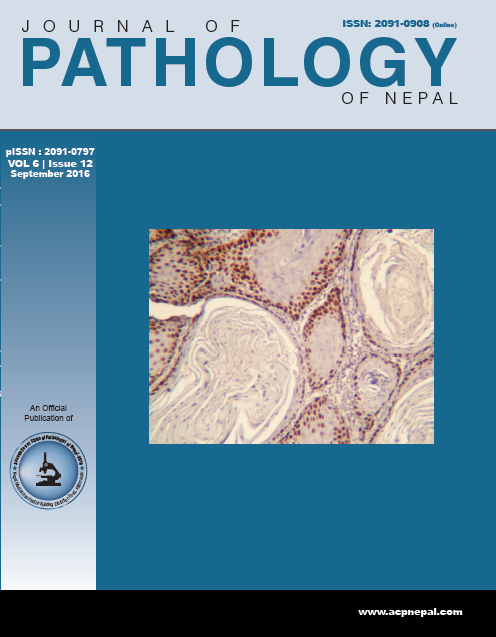Papillary carcinoma thyroid – A cytomorphological study
DOI:
https://doi.org/10.3126/jpn.v6i12.16288Keywords:
Nuclear grooving, Pseudoinclusion, Thyroid, PapillaryAbstract
Background: Fine Needle Aspiration Cytology is a widely accepted diagnostic tool for thyroid lesions. It is well known that nuclear features form the mainstay of diagnosis for papillary carcinoma thyroid. Focal nuclear features can be missed unless carefully looked for and pose diagnostic dif culty. The aim was to study the cytomorphological features of papillary carcinoma thyroid and to calculate the percentage of nuclear grooving.
Materials and Methods: This retrospective study was carried out by reviewing the data and cytology smears of 21 histopathologically con rmed cases of papillary carcinoma thyroid. The percentage of nuclear grooves was calculated in oil immersion by counting 200 to 500 cells depending on the cellularity. The study was approved by the institution ethical and research committee.
Results: Out of the total 21 cases, 03(14.2%) were males and 18(83.8%) were females. Mean age was 38.9years. Predominant papillary arrangement was seen in 17(80.9%) of the cases. Nuclear crowding and overlapping, pale chromatin, nuclear grooves, nuclear enlargement and prominent nucleoli were seen in all (100%) the cases. Intranuclear cytoplasmic pseudoinclusions were seen in only 5(23.8%) of the cases. The percentage of nuclear grooving ranged from 15% to 85%. Greater than 20% nuclear grooves were observed in 19(90.4%) of the cases. Histiocytes, metaplastic cells and multinucleated giant cells were seen in 12(57.1%), 10(47.6%) and 6(28.5%) of the cases.
Conclusion: The cytologic diagnosis of papillary carcinoma is easy when majority of the classical features are present. But it becomes really challenging when the features are either present focally or classical features are absent.
Downloads
Downloads
Published
How to Cite
Issue
Section
License
This license enables reusers to distribute, remix, adapt, and build upon the material in any medium or format, so long as attribution is given to the creator. The license allows for commercial use.




